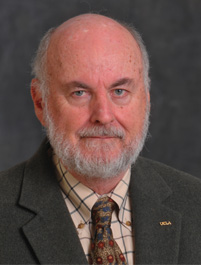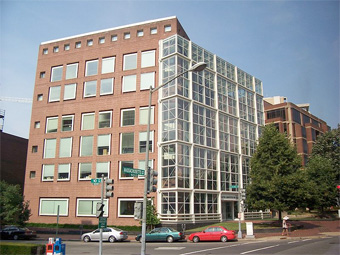Last week we published a reply from UCLA planning professor Donald Shoup to Cato Institute senior fellow Randal O’Toole, in which Shoup clarified his positions on parking policy and explained several ways in which government regulations favor the provision of free parking. In response, O’Toole ran this post on the Cato@Liberty blog. Streetsblog is pleased to publish Shoup’s follow-up, which suggests Cato estimate the price distortions that give incentives for the libertarian think tank’s employees to commute by car. By doing so, Cato headquarters could serve as a laboratory for leveling the commute subsidy playing field, an idea embedded in Oregon Congressman Earl Blumenauer’s Green Routes to Work Act.
Dear Randal,

Thanks for your Cato@Liberty post clarifying several points where we agree about parking policies.
You wrote that the Cato Institute offers free parking to its employees. The market price of commuter parking in the commercial garage closest to the Cato Institute is $255 a month (in Colonial Parking at 901 New York Avenue). At this market price, can you calculate the total market value of all the free parking Cato provides to its automobile commuters?
After examining the data, you may find the market value of the Cato Institute’s free parking is surprisingly high. My rough guess is at least $10,000 a month. That is one example of what I mean by the high cost of free parking.
But maybe I am wrong. I hope the Cato Institute will tell you the number of commuters who park free so that you can answer this simple question. What is the fair market value of all the free parking for commuters who drive to the Cato Institute?
My point is not to criticize the Cato Institute for its free parking, because 95 percent of all automobile commuters park free at work in the United States. My point is that you could do a great service to free-market transportation policy by using the Cato Institute as a case study to analyze how employer-paid parking distorts commuter transportation choices.

Valued at market prices, free parking at the Cato Institute reduces the cost of driving to work by $255 a month. If commuters drive the national average round-trip distance of 32 miles a day for 22 days a month, free parking thus reduces the cost of driving to work by 36¢ per mile ($255/22 days/32 miles). According to the AAA, the average operating cost of a car is about 18¢ per mile. Because the parking subsidy at work is twice the operating cost of driving to work, free parking at Cato reduces the out-of-pocket costs of driving to work by two-thirds. Free parking is therefore a huge price distortion in favor of commuting by car.
The Internal Revenue Code creates an incentive for this price distortion because free parking at work is exempt from both income and payroll taxes. Parking cash out can eliminate this price distortion. Parking cash out is a market-oriented policy whereby employers who offer free parking at work also offer commuters the option to choose its cash value in lieu a parking space. Parking cash out does not mandate parking charges because commuters who choose to drive can still park free. Parking cash out simply gives the same subsidy to every commuter, regardless of travel mode choice, while free parking gives a subsidy to drivers and nothing to other commuters. Parking cash out expands choice, which I assume is a core value of the Cato Institute.
A bill now in Congress would alter the Internal Revenue Code to reduce the price distortion in favor of free parking. Section 5 of H.R. 3271 (Blumenauer) would include parking cash out as a condition to qualify for the tax exemption for employer-paid parking. That is, the free parking would be a tax-exempt fringe benefit if employers offer commuters the option to cash it out. The bill would allow commuters to make their transportation choices at fair market prices.
Data from the Cato Institute can illustrate how H. R. 3271 would allow market parking prices to influence transportation choices, without eliminating free parking. I hope the Cato Institute will therefore provide the data necessary to estimate the total market value of all the free commuter parking it provides, and how parking cash out would affect the prices for commuting to its building. After all, if the Cato Institute will not make data available to analyze how market prices can improve transportation choices, who will?
Donald Shoup
Department of Urban Planning
University of California, Los Angeles
Sent in response to this post by Randal O’Toole on Cato@Liberty:
Donald Shoup on Free ParkingPosted by Randal O’Toole
Donald Shoup, the author of The High Cost of Free Parking, has posted a response to my first post about Tyler Cowen’s op ed against free parking. Shoup points out that I erroneously attributed proposals to him that are in fact only urged by his followers, such as maximum-parking requirements and requirements that all businesses charge for parking. I apologize for that.
In fact, Shoup’s book argues that cities should eliminate minimum-parking requirements and charge market rates for on-street parking. I favor these things as well. Where we may disagree is about the effects of these policies.
My post pointed out that many municipalities do not have minimum-parking requirements, but businesses still offer plenty of free parking to their employees and customers. Shoup asks for “a list of some of these.” Virtually all counties in Texas, most counties in Nevada, and many counties in Indiana have no minimum-parking requirements, and I am sure I could find counties in many other states as well. Unlike California, where Shoup lives, and Oregon, where I live, these states do not restrict urban development to within city limits or urban-growth boundaries, and developments in unincorporated parts of these counties offer plenty of free parking.
Much of Shoup’s response seems to assume that my posts were defending minimum-parking requirements. “City planners have no training that would enable them to estimate the demand for parking, and no financial stake in the success of a development,” says Shoup. “They know much less than developers do about how many parking spaces to provide for each project.” As I pointed out in my later posting on this issue, I entirely agree. My goal was to defend private provision of free parking.
That said, I think Shoup’s worries about the “high cost” of parking are overblown. As I pointed out in my first post, surface parking is cheap, and even structured parking is not terribly expensive in the long run. Most of Shoup’s analysis is not of the high cost of free parking but the high cost of minimum-parking requirements, and there the cost is only of the spaces that developers are forced to provide that they wouldn’t otherwise provide. Shoup and I seem to agree that businesses who want to free parking should be allowed to do so.
Unfortunately, many urban planners disagree; they want to set maximum-parking limits, and they often cite Shoup in their plans and proposals. The negative effects of such limits are likely to be as bad if not worse than minimum-parking requirements. Planners promote such limits in order to discourage driving, which planners say is bad.
Shoup himself relies on anti-auto rhetoric. “Ubiquitous free parking helps explain why American motor vehicles, by themselves, consume one-eighth of the world’s total oil production,” Shoup says, for example. “America’s extravagant consumption of imported oil to fuel our cars is not sustainable, economically or environmentally, and anything that is not sustainable must eventually stop.” But we can find many alternatives to “extravagant consumption of imported oil” without limiting people’s mobility the way many urban planners want to do.
Planners with Portland’s Metro, for example, have set a goal of allowing congestion on most of the region’s highways to reach level of service F (meaning stop-and-go driving). They also promote “traffic calming” (a euphemism for congestion building), “boulevarding” (a euphemism for taking lanes away from autos in busy thoroughfares), and other anti-auto policies. But their own analyses found that these policies would have very little effect on the amount of driving people do. The biggest effect came from a plan to require that all businesses in the region charge for parking — yet even that effect was small, estimated to reduce per capita driving by about 2 percent. Even though such a plan has not been put into effect, at least a few years ago Metro’s transportation models assumed that it would be put into effect sometime in the next couple of decades.
As I have shown at length, trying to save energy or reduce auto emissions by reducing driving is not cost effective, and the resulting reduction in mobility could have serious negative effects on our economy. Instead, it is much more cost effective to make the cars we drive more energy efficient and/or capable of using alternative fuels, and if oil prices go up that will happen without government coercion anyway.
Although Shoup teaches in an urban planning school, he is actually an economist, and he and I share many areas of agreement. I won’t even mind if it turns out that I am wrong: if cities get rid of minimum-parking requirements without imposing maximum-parking limits and it leads businesses to charge for parking that are now offering it for free, that’s just the market at work. My only concern is that many planners are using Shoup’s work to promote their own coercive agendas. I hope he responds to them as vigorously as he responded to me.
One more thing: Shoup asks, “Can you tell me if the Cato Institute offers free parking for its employees? If so, does it also offer commuters the option to cash out their parking subsidies?” I do not work in Cato’s Washington, DC, office, but as far as I know it does offer free parking to at least some of its employees and does not provide a cash-out option. Cato is currently expanding its building and I understand it is installing showers for cyclists, as required by DC zoning codes, and is not providing a cash-out option for cyclists (or other employees) who do not plan to use those showers. As a cyclist, I’ll probably use those showers from time to time on my visits to DC. Perhaps someday Dr. Shoup and I will write a paper titled, “The High Cost of Free Showers.”





